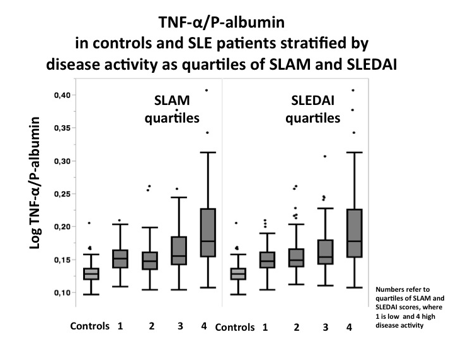Session Information
Date: Sunday, November 8, 2015
Title: Systemic Lupus Erythematosus - Clinical Aspects and Treatment Poster Session I
Session Type: ACR Poster Session A
Session Time: 9:00AM-11:00AM
Background/Purpose:
There is
presently no consensus on how to best measure disease activity in systemic
lupus erythematosus (SLE). Available validated
measures, such as SLE Disease Activity Index (SLEDAI) and SLE Activity Measure
(SLAM), are composite scores that in addition to laboratory tests require
investigation by a physician. These scores are insensitive to change and have
failed to differentiate treatment responses in clinical trials. It would be an
important step forward, for clinical practice and for clinical trials, if one
or several biomarkers could be used as proxies for disease activity in SLE.
Methods:
In a cross-sectional
setting we examined 433 patients with SLE (fulfilling four or more of the 1982 revised ACR criteria) and
322 age and gender matched population controls. Disease activity was assessed
according to both SLEDAI and SLAM by a rheumatologist. Basic laboratory tests
and analyses on MSD 30-plex
cytokine assay (Mesoscale Discovery, K15054D)
were performed on fasting blood samples (total >50 biomarkers). The
discriminatory power for investigated biomarkers was tested between patients
and controls. Correlations with SLAM/SLEDAI scores were calculated among
patients.
Results:
Many
biomarkers discriminated between patients and controls. Best discriminatory
power (p<1×10-35) was observed for: TNF-α, IL-6, orosomucoid, plasma (P)-albumin and sedimentation rate
(SR), see table.
Variables
with the strongest correlation with SLAM/SLEDAI (Spearman correlation ρ>0.20 or ρ<-0.20) are presented in the
table. Strong positive correlations were observed for TNF-α, and negative for P-albumin. The ratio between TNF- α and P-albumin improved the correlations, see figure. As SR is part of
SLAM, and Complement factor 4 (C4) an item in SLEDAI, expected positive
correlations were observed, see table.
Conclusion:
Of more
than 50 investigated biomarkers TNF-α was the best discriminator between
SLE patients and controls. Furthermore TNF-α was the
biomarker, which correlated best with disease activity. These correlations were
further improved by the ratio between TNF-α and
P-albumin. We propose that the TNF-α/P-albumin ratio merits further
investigations as a clinically useful biomarker for diagnostic and surveillance
purposes in SLE.
To cite this abstract in AMA style:
Eketjäll S, Idborg H, Gustafsson J, Zickert A, Kvarnstrom M, Oke V, Pettersson S, Jakobsson PJ, Gunnarsson I, Svenungsson E. The Ratio Between TNF-a and P-Albumin – a Suggested Measure of Disease Activity in SLE [abstract]. Arthritis Rheumatol. 2015; 67 (suppl 10). https://acrabstracts.org/abstract/the-ratio-between-tnf-a-and-p-albumin-a-suggested-measure-of-disease-activity-in-sle/. Accessed .« Back to 2015 ACR/ARHP Annual Meeting
ACR Meeting Abstracts - https://acrabstracts.org/abstract/the-ratio-between-tnf-a-and-p-albumin-a-suggested-measure-of-disease-activity-in-sle/


